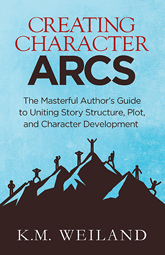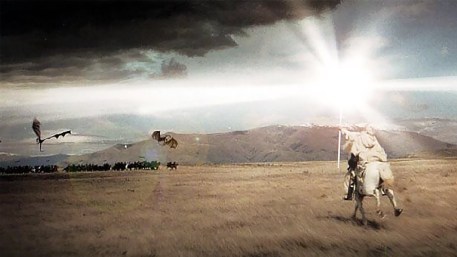Archetypal Character Arcs, Pt. 15: Introduction to the 6 Flat Archetypes
 In studying character arcs, writers easily recognize Positive-Change Arcs and Negative-Change Arcs. But somewhat more baffling can be the stories that appear to feature neither. These are stories in which the protagonist does not change or seems to have no character arc at all. How do these stories fit into the discussion of archetypal character arcs?
In studying character arcs, writers easily recognize Positive-Change Arcs and Negative-Change Arcs. But somewhat more baffling can be the stories that appear to feature neither. These are stories in which the protagonist does not change or seems to have no character arc at all. How do these stories fit into the discussion of archetypal character arcs?
If you’ve studied foundational character-arc theory and practice with me before, you know there are two possible answers to the seeming conundrum of the “character with no arc.”
One is simply that he or she doesn’t arc. Both the protagonist, the supporting cast, and the story world itself remain relatively unchanged from beginning to end, despite everyone’s adventures. Indeed, the very point of their adventures might be to maintain a desirable status quo.
The other possibility is that the unchanging protagonist is in fact spearheading what I call a Flat Arc. As the name suggests, this is an arc in which the protagonist—the story’s central actor—remains thematically unchanged, but uses his or her understanding of the story’s central thematic Truth to catalyze change arcs in the supporting characters. (Flat-Arc protagonists are usually positive influences, or Impact Characters, but if their fixation is on the thematic Lie rather than the Truth, they can also be instrumental in catalyzing Negative-Change Arcs for the supporting characters.)

Creating Character Arcs (Amazon affiliate link)
Over the last few months, we have explored six successive “life arcs,” represented by the Positive-Change Arcs of six primary archetypes—the Maiden, the Hero, the Queen, the King, the Crone, and the Mage. Each of these positive archetypes represents a rising above the limitations of the previous archetype in the cycle. They also inherently represent a struggle with twelve related “shadow” or negative archetypes—the Damsel/Vixen, the Coward/Bully, the Snow Queen/Sorceress, the Puppet/Tyrant, the Hermit/Witch, and the Miser/Sorcerer.
As unchanging characters, Flat-Arc protagonists are equally archetypal. But unlike the six Positive-Change Arcs, they do not demonstrate a “journey” from one archetype to another (e.g., Maiden to Hero). Rather, they represent the interstitial period of a character’s life, in which the character may be seen to be “resting” in between personal transformations. As such, these Flat archetypes are often seen to be helping or teaching other characters some of the same lessons they just learned in their own previously completed arcs.
6 Flat or “Resting” ArchetypesThe six flat or resting archetypes can be seen like this:
1. Child (precedes Maiden Arc)
2. Lover (precedes Hero Arc)
3. Parent (precedes Queen Arc)
4. Ruler (precedes King Arc)
5. Elder (precedes Crone Arc)
6. Mentor (precedes Mage Arc)
As you can see, many of these Flat archetypes initially seem synonymous with the change arcs that follow (e.g., Ruler/King, Crone/Elder). In some ways, they are synonymous, in large part because each of the Positive-Change archetypes begins its First Act within the complacency of the preceding Flat archetype. For example, the King Arc begins with the character clearly a Ruler, but the story does not leave him as such, since by the end he will be asked to give up his throne in some way. However, a story that is about the Flat archetype is one in which the protagonist will begin and end within the same archetype. If he begins as a Ruler, he will end as a Ruler, still upon his throne in the story’s conclusion.
How to Use Flat Archetypes in a StoryFlat Arcs are anything but boring. They offer the potential to unapologetically present archetypal characters who do what we all want to do—enact meaningful change on the world around us. (Depending on whether the protagonist is aligned with the story’s thematic Truth or Lie, that change may be more or less positive or negative. But for the sake of this discussion, since we’ve already discussed the negative archetypes, we will be assuming that the archetypal protagonists featured in these Flat-Arc stories are positive in their alignment with a beneficial Truth. In short, these characters are likely to be in between their own Positive-Change Arcs.)
As mentioned, the hallmark of a Flat Arc (in contrast to a story with “no arc”) is that the protagonist is able to create significant change in the world around him. He is the Impact Character in someone else’s Positive-Change Arc.
Particularly within the cycle of the archetypal life arcs we’ve been discussing this year, the Flat archetypes represent moments within the protagonist’s life in which he or she is able to put to use the lessons learned in previous arcs.
Therefore:
Adolescent awakening demands the Child undertake her coming-of-age initiation as the Maiden, who then explores a burgeoning into adulthood as the Lover.
The Lover must then embark on the Hero’s quest, but comes home from his adventures and settles down to become a Parent.
As her own children begin reaching maturity, the Parent must then rise up as Queen to defend and properly lead them.
Having been crowned, he may spend years as the Ruler of the Kingdom, before then taking the sacrificial King Arc.
Now an Elder, the character influences subsequent generations on the way to undergoing a full Crone Arc.
Finally, the character may bless the Kingdom as one of the most archetypal characters of all—the Mentor—before finally entering the final journey of the Mage.
As always, all of these titles are symbolic. A character does not literally need to be a parent in order to represent the Parent archetype, anymore than a Mage character must literally be able to work magic. We will discuss this further in each subsequent post.
How the Positive Archetypes Relate to the Flat ArchetypesFlat Arc stories are, in fact, Positive-Change Arc stories in disguise. Although they seem at first glance to be stories in which there is no arc, this is an illusion. The protagonist doesn’t change, but at least one supporting character does.
As such, you can often overlay any appropriate Positive-Change archetypal journey upon the Flat-Arc character’s story—but with a supporting character enacting the actual journey. The Flat archetypal protagonist will still be the primary actor within the conflict (which is ultimately how we define which character is the protagonist). But his or her actions and adherence to the thematic Truth will allow other characters to move forward in their own life journeys. Depending on the specifics of the story, the Change-Arc supporting character may feature prominently or as more of a subplot.
We can see how this works perhaps most obviously in the relationship between the Hero and the Mentor. The flat Mentor archetype is an easily recognizable Impact Character within the classical Hero’s Journey. But if we flip the script from a Hero Arc into a Mage Arc, the Mentor becomes the protagonist, and the Hero becomes a supporting character. Unlike a Hero Arc, in which the Mentor almost always dies to facilitate a sensible reason for the immature Hero to be the one to end the conflict, a Mage Arc often pits the Hero and the Mage against differing and more “age-appropriate” antagonists.
A perfect example of this can be found in The Lord of the Rings, in which Gandalf—a universally-recognized archetypal Mentor character—is in fact arguably the story’s protagonist. Certainly, he displays agency and centrality to the conflict throughout. But he focuses on the supernatural antagonists that only he can confront, while the Heroes, Queens, and Kings are inspired by his example to fight their own battles and enact their own change arcs.

None of the Flat archetypes we will be discussing are naturally negative—although the already-discussed shadow archetypes are often, in themselves, relatively static. The passive negative archetypes in particular tend to remain stuck in their own fear and complacency. These characters can be used as protagonist or antagonists within Negative Flat Arcs—in which the protagonist changes supporting characters for the worse.
However, in regards to the Flat archetypes we will be discussing over the next month and a half, the shadow archetypes are more likely to show up either as antagonists or as the supporting characters who will be inspired to undertake a positive journey by the end of the story.
Usually, any negative archetypes within a Flat-Arc story will be those from arcs that preceded the protagonist’s. For example, if the protagonist is a Parent (the flat or “resting” form of the Queen), then she is most likely to interact with the negative archetypes of Damsel/Vixen, Coward/Bully, or Snow Queen/Sorceress. This is because these “younger” archetypes are the only ones she is equipped to help or defeat at this stage of her own growth. Should she be challenged by a later negative archetype—such as the Puppet/Tyrant—she would need to advance out of the Parent archetype and change into a full-blown Queen Arc.
A Flat-Arc story will be about a character who understands something important that the rest of the story world does not. It is a story about this character using this understanding to advance and benefit the current story world.
***
Flat-Arc stories are not mythic journeys in the same way as the six foundational life-arc archetypes. Although they will often feature glimpses of supporting characters taking these journeys, the Flat Arcs themselves more varied and episodic than the six Positive-Change character arcs. There are many types of stories that can be told about a Child or a Ruler or an Elder. Indeed, many people spend years, decades even, within the same Flat archetype before life confronts them with new challenges that demand they journey on into the subsequent life arc.
As such, I won’t be offering a “mythic beat sheet” for the flat archetypes in the same way as I did for the positive archetypes. The only consistent beat sheet for the Flat Arcs is that of the Flat-Arc character arc structure itself.
Over the course of the next six posts (the final section in this very long series!), we will be diving into the foundational aspects of these interstitial Flat archetypes—and looking at how you can recreate these important archetypes within your own stories.
Stay Tuned: Next week, we will study the Flat archetype of the Child.
Related Posts:
Story Theory and the Quest for MeaningAn Introduction to Archetypal StoriesArchetypal Character Arcs: A New SeriesThe Maiden ArcThe Hero ArcThe Queen ArcThe King ArcThe Crone ArcThe Mage ArcIntroduction to the 12 Negative ArchetypesThe Maiden’s Shadow ArchetypesThe Hero’s Shadow ArchetypesThe Queen’s Shadow ArchetypesThe King’s Shadow ArchetypesThe Crone’s Shadow ArchetypesThe Mage’s Shadow ArchetypesWordplayers, tell me your opinions! Are you more drawn to writing Flat or Change Arcs? Tell me in the comments!Click the “Play” button to Listen to Audio Version (or subscribe to the Helping Writers Become Authors podcast in Apple Podcast or Amazon Music).
___
Love Helping Writers Become Authors? You can now become a patron. (Huge thanks to those of you who are already part of my Patreon family!)The post Archetypal Character Arcs, Pt. 15: Introduction to the 6 Flat Archetypes appeared first on Helping Writers Become Authors.




